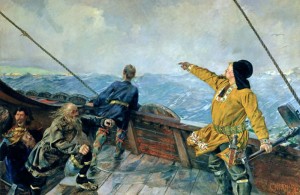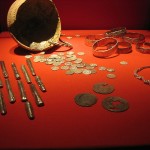
Patricia Sutherland is a very stubborn woman, the kind of damn-the-torpedoes, full-speed-ahead brand of stubbornness that the Scots and their descendants long ago perfected. Sutherland is an archaeologist at the Canadian Museum of Civilization in Ottawa and one of the world’s leading experts on the prehistory of the Arctic. Silver-haired, bespectacled, and notably fond of pantsuits, she doesn’t look much like a maverick. But since the late 1990s, Sutherland has been turning Arctic archaeology upside down.
Sutherland proposes that 1000 years or so ago, Norse seafarers–better known in pop culture as the Vikings–took part in a kind of medieval get-rich quick scheme in the Canadian Arctic. According to Sutherland,the Norse traded small bits of wood to Arctic dwellers known as the Dorset for luxurious furs and shimmering walrus ivory that could be sold for a king’s ransom in Europe. And Sutherland is not whistling Dixie. She has assembled an impressive mountain of evidence–from Norse yarn, Norse whetstones and other Norse artifacts found at four sites on Baffin Island and northern Labrador.
You might wonder why you haven’t heard about ancient Norse merchants in the Canadian Arctic. The answer is complex but it largely comes down to this. The search for Norse voyagers in North America is primarily the purview of amateurs and kooks who claim to have turned up Viking runes and ruins all along the Eastern Seaboard. None of these sites, however, with the sole exception of the Norse settlement at L’Anse aux Meadows in Newfoundland, has been accepted by the archaeological community.
Loathe to be lumped in with the amateurs and determined to present an ironclad case, Sutherland has slaved away at her Arctic research far from the limelight. Since 1999, when she first discovered two strands of Norse yarn in a tray of artifacts excavated by another researcher on northern Baffin Island, Sutherland has searched doggedly for traces of the Norse in the far north.

She has sifted through 15,000 Arctic artifacts dug by others and stored at the Canadian Museum of Civilization and compared the most promising of the finds to medieval Norse artifacts in museums in Denmark, Greenland, Iceland, England and Russia. In addition, she has examined four Arctic sites yielding Norse artifacts and conducted excavations at the most important. Her dig turned up what certainly appears to be a hastily built Norse stone-walled shelter on southern Baffin Island, as well as the pelts of ship-borne European rats that once scurried through the walls.
Impressed by the finds, Peter Pope, head of the department of archaeology at Memorial University in St. John’s, Newfoundland, calls Sutherland’s work “very significant and fascinating.”
I have been following Sutherland’s work now for the past decade, reporting on it here and here. When I talked to her this week, I learned that she was unable to get into the field this summer because she had badly damaged one of her shoulders–most likely from heaving fifty-pound boxes of gear off helicopters.
I sincerely hope that Pat is back in fighting form and fit for the field soon. She is stubbornly and almost singlehandedly opening a new chapter of history. I, for one, am very keen to see what it says.
Upper Image: Christian Krogh’s 1893 painting of Leif Eiriksson discovering America
Lower Photo: A hoard of Viking treasure now located in the Rijksmuseum van Oudheden (Leiden Museum). Photo by Marieke Kuijjer.
Ms. Pringle:
It has taken 1,000 years but Eirik and Leif’s relatives are going home, “fara heim”, via the sea routes originally taken. On the journey we will search for artifacts of Norse presence along the coastal areas between Churchill, Manitoba to Iceland.
Satellite imagery makes it painfully clear that any experienced sailor would investigate west into Hudson Bay just as easily as they would choose to go south down the coast. As we continue to research sites to search we are looking for the input of “amateurs and kooks” as well as respected academics. You never know where a great lead may come from. To build awareness of our interest in getting information on possible sites we are asking for input from all sources and are building a page on our site to allow for the public (amateur and academic) to cast their vote on where we should go.
Social media has been a great help to us and if you need a blog topic we would greatly appreciate your help.
Sincerely,
David Collette